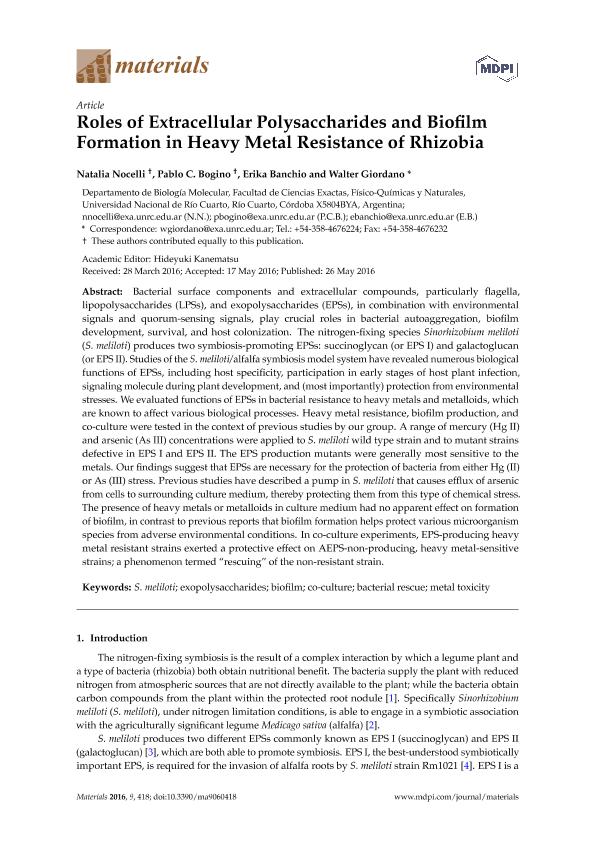Mostrar el registro sencillo del ítem
dc.contributor.author
Nocelli, Natalia Estefanía

dc.contributor.author
Bogino, Pablo Cesar

dc.contributor.author
Banchio, Erika

dc.contributor.author
Giordano, Walter Fabian

dc.date.available
2022-12-01T14:13:05Z
dc.date.issued
2016-05
dc.identifier.citation
Nocelli, Natalia Estefanía; Bogino, Pablo Cesar; Banchio, Erika; Giordano, Walter Fabian; Roles of extracellular polysaccharides and biofilm formation in heavy metal resistance of rhizobia; Multidisciplinary Digital Publishing Institute; Materials; 9; 6; 5-2016; 1-19
dc.identifier.issn
1996-1944
dc.identifier.uri
http://hdl.handle.net/11336/179785
dc.description.abstract
Bacterial surface components and extracellular compounds, particularly flagella, lipopolysaccharides (LPSs), and exopolysaccharides (EPSs), in combination with environmental signals and quorum-sensing signals, play crucial roles in bacterial autoaggregation, biofilm development, survival, and host colonization. The nitrogen-fixing species Sinorhizobium meliloti (S. meliloti) produces two symbiosis-promoting EPSs: succinoglycan (or EPS I) and galactoglucan (or EPS II). Studies of the S. meliloti/alfalfa symbiosis model system have revealed numerous biological functions of EPSs, including host specificity, participation in early stages of host plant infection, signaling molecule during plant development, and (most importantly) protection from environmental stresses. We evaluated functions of EPSs in bacterial resistance to heavy metals and metalloids, which are known to affect various biological processes. Heavy metal resistance, biofilm production, and co-culture were tested in the context of previous studies by our group. A range of mercury (Hg II) and arsenic (As III) concentrations were applied to S. meliloti wild type strain and to mutant strains defective in EPS I and EPS II. The EPS production mutants were generally most sensitive to the metals. Our findings suggest that EPSs are necessary for the protection of bacteria from either Hg (II) or As (III) stress. Previous studies have described a pump in S. meliloti that causes efflux of arsenic from cells to surrounding culture medium, thereby protecting them from this type of chemical stress. The presence of heavy metals or metalloids in culture medium had no apparent effect on formation of biofilm, in contrast to previous reports that biofilm formation helps protect various microorganism species from adverse environmental conditions. In co-culture experiments, EPS-producing heavy metal resistant strains exerted a protective effect on AEPS-non-producing, heavy metal-sensitive strains; a phenomenon termed “rescuing” of the non-resistant strain.
dc.format
application/pdf
dc.language.iso
eng
dc.publisher
Multidisciplinary Digital Publishing Institute
dc.rights
info:eu-repo/semantics/openAccess
dc.rights.uri
https://creativecommons.org/licenses/by-nc-sa/2.5/ar/
dc.subject
BACTERIAL RESCUE
dc.subject
BIOFILM
dc.subject
CO-CULTURE
dc.subject
EXOPOLYSACCHARIDES
dc.subject
METAL TOXICITY
dc.subject
S. MELILOTI
dc.subject.classification
Biología Celular, Microbiología

dc.subject.classification
Ciencias Biológicas

dc.subject.classification
CIENCIAS NATURALES Y EXACTAS

dc.title
Roles of extracellular polysaccharides and biofilm formation in heavy metal resistance of rhizobia
dc.type
info:eu-repo/semantics/article
dc.type
info:ar-repo/semantics/artículo
dc.type
info:eu-repo/semantics/publishedVersion
dc.date.updated
2022-11-30T22:32:29Z
dc.journal.volume
9
dc.journal.number
6
dc.journal.pagination
1-19
dc.journal.pais
Suiza

dc.journal.ciudad
Basel
dc.description.fil
Fil: Nocelli, Natalia Estefanía. Universidad Nacional de Río Cuarto. Facultad de Ciencias Exactas Fisicoquímicas y Naturales. Departamento de Biología Molecular; Argentina. Consejo Nacional de Investigaciones Científicas y Técnicas. Centro Científico Tecnológico Conicet - Córdoba; Argentina
dc.description.fil
Fil: Bogino, Pablo Cesar. Universidad Nacional de Río Cuarto. Facultad de Ciencias Exactas Fisicoquímicas y Naturales. Departamento de Biología Molecular; Argentina. Consejo Nacional de Investigaciones Científicas y Técnicas. Centro Científico Tecnológico Conicet - Córdoba; Argentina
dc.description.fil
Fil: Banchio, Erika. Universidad Nacional de Río Cuarto. Facultad de Ciencias Exactas Fisicoquímicas y Naturales. Departamento de Biología Molecular; Argentina. Consejo Nacional de Investigaciones Científicas y Técnicas. Centro Científico Tecnológico Conicet - Córdoba; Argentina
dc.description.fil
Fil: Giordano, Walter Fabian. Universidad Nacional de Río Cuarto. Facultad de Ciencias Exactas Fisicoquímicas y Naturales. Departamento de Biología Molecular; Argentina. Consejo Nacional de Investigaciones Científicas y Técnicas. Centro Científico Tecnológico Conicet - Córdoba; Argentina
dc.journal.title
Materials
dc.relation.alternativeid
info:eu-repo/semantics/altIdentifier/doi/http://dx.doi.org/10.3390/ma9060418
dc.relation.alternativeid
info:eu-repo/semantics/altIdentifier/url/https://www.mdpi.com/1996-1944/9/6/418
Archivos asociados
